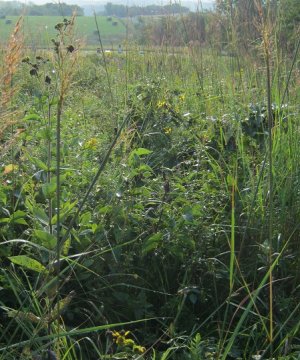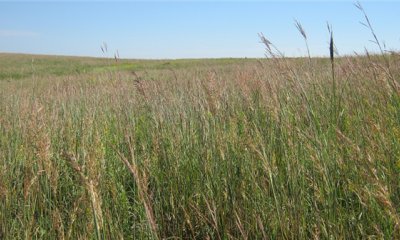
Till Upland Prairie
Scenario model
Current ecosystem state
Select a state
Management practices/drivers
Select a transition or restoration pathway
- Transition T1A More details
- Transition T2A More details
- Transition T1C More details
- Restoration pathway R2A More details
- Transition T2A More details
- Transition T2B More details
- Transition T3A More details
- Transition T3B More details
- Restoration pathway T4A More details
- Transition T4B More details
- Restoration pathway R5A More details
- Restoration pathway T5A More details
-
No transition or restoration pathway between the selected states has been described
Target ecosystem state
Select a state
Description
This State is native tall grass prairie dominated by little bluestem, big bluestem and a wide variety of prairie wildflowers. This State occurs on level to gently sloping soils. In some cases, bur oak, swamp white oak, post oak, elm, American hazelnut, prairie willow and wild plum occurred in small groves or as scattered individuals across the prairie landscape.
Two phases can occur that will transition back and forth depending on fire frequencies. Longer fire free intervals will allow woody species to increase such as prairie willow, dogwoods and wild plum. When fire intervals shorten these woody species will decrease.
This State is rare. Most sites have been converted to cool season grassland and intensive agriculture cropland.
Submodel
Description
Degraded reference states that have experienced fire suppression for 20 or more years will transition to this state. With fire suppression, woody species such as bur oak and eastern redcedar will begin to increase transitioning this state from a prairie to a Woody Invaded Savanna. Native ground cover will also decrease and invasive species such as tall fescue may begin to dominate. Transition from this state to cool season grasslands (State 3) or intensive cropland (State 4) was very common.
Submodel
Description
Conversion of other states to non-native cool season species such as tall fescue, orchard grass and red clover has been common in this area. Occasionally, these pastures will have scattered bur oaks.
Long term uncontrolled grazing and a lack of grassland management can cause significant soil erosion and compaction and increases in less productive species such as Kentucky bluegrass and weedy forbs such as ironweed. A return to the Reference State may be impossible, requiring a very long term series of management options.
Submodel
Description
This is the dominant State that exists currently with intensive cropping of corn, soybeans, and wheat occurring. Some conversion to cool season hayland occurs for a limited period of time before transitioning back to cropland. Limited acres are sometimes converted to native warm season grassland.
Submodel
Description
Conversion from the Cool Season Grassland (State 3) or the Cropland (State 4) to this State is increasing due to renewed interest in warm season grasses as a supplement to cool season grazing systems or as a native restoration activity.
Submodel
Mechanism
Woody removal; tillage; vegetative seeding; grassland management
Mechanism
Woody removal; tillage; vegetative seeding; grassland management
Mechanism
Vegetative seeding; prescribed fire 1-3 years
Model keys
Briefcase
Add ecological sites and Major Land Resource Areas to your briefcase by clicking on the briefcase (![]() ) icon wherever it occurs. Drag and drop items to reorder. Cookies are used to store briefcase items between browsing sessions. Because of this, the number of items that can be added to your briefcase is limited, and briefcase items added on one device and browser cannot be accessed from another device or browser. Users who do not wish to place cookies on their devices should not use the briefcase tool. Briefcase cookies serve no other purpose than described here and are deleted whenever browsing history is cleared.
) icon wherever it occurs. Drag and drop items to reorder. Cookies are used to store briefcase items between browsing sessions. Because of this, the number of items that can be added to your briefcase is limited, and briefcase items added on one device and browser cannot be accessed from another device or browser. Users who do not wish to place cookies on their devices should not use the briefcase tool. Briefcase cookies serve no other purpose than described here and are deleted whenever browsing history is cleared.
Ecological sites
Major Land Resource Areas
The Ecosystem Dynamics Interpretive Tool is an information system framework developed by the USDA-ARS Jornada Experimental Range, USDA Natural Resources Conservation Service, and New Mexico State University.


